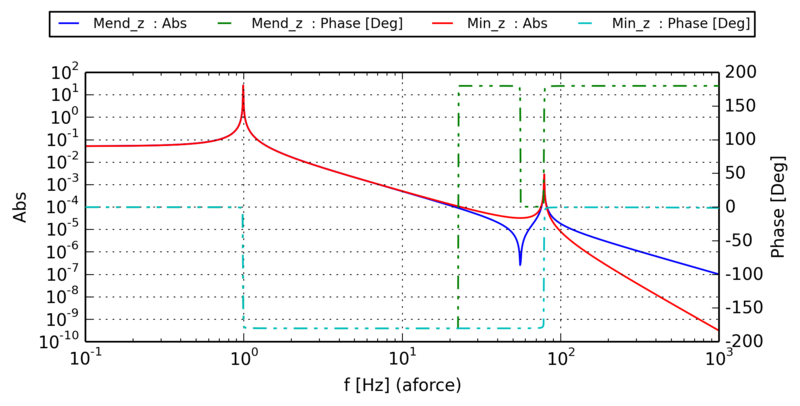Optical spring
(An optics simulation with Finesse)
The following shows a simple example for a Finesse simulation of an optical spring, including the text input file, a brief explanation and the resulting plot.
The input file
%------------------------------------------------------------------------ % Finesse input file to model a cavity with an optical spring % Setup based on Corbitt, et. al, 'Measurement of radiation-pressure- % induced optomechanical dynamics in a suspended Fabry-Perot cavity' % Physical Review A, 2006, 74, 021802 % http://pra.aps.org/abstract/PRA/v74/i2/e021802 % Daniel Brown 21.03.2014 %------------------------------------------------------------------------ l l1 3 0 n1 # laser s s1 1 n1 n2 # the cavity m Min 0.9937 0.0063 0 n2 n3 s cav1 1 n3 n4 m Mend 1 0 -0.048 n4 n5 # roughly 40kHz detuning # apply mass and longitudinal transfer function to mirrors tf sus1 1 0 p 1 1000 # pole at 1Hz, Q=1000 attr Min mass 0.25 zmech sus1 attr Mend mass 0.25 zmech sus1 # apply a `force signal' to the end mirror fsig aforce Mend Fz 1 0 # we want to measure the longitudinal motion signal of both mirrors xd Mend_z Mend z xd Min_z Min z xaxis aforce f log 0.1 1k 1000 yaxis log abs:deg
The optical layout

The optical layout shows a laser beam being injected into a Fabry-Perot cavity. What we want to model here is how both of the mirrors move if we apply a force to only one of them. In this example a force is applied the end cavity mirror. Note, that the cavity must be tuned slightly away from resonance for the optical spring to occur.
Output graphs

The plot shows the magnitude and phase of both mirrors' motion. An unexpected result, you may think, is that by applying a force to only one mirror, also the other one moves, despite the absence of any mechanical link between them. However, the optical beam now couples the motions of the two mirrors. This behaviour is called an optical spring: the light field circulating in the cavity essentially creates exactly the same effect as if a physical spring were connecting the mirrors. Concentrating on the magnitude of the motions first, we see 2 resonances: the first being the mechanical resonance of the mirror suspensions, the second being the resonance of the optical spring. If we considering the phase of the motions we can see that at low frequency the mirrors move exactly in-phase, thus the whole cavity moves together; this is called optical rigidity and can approach the stiffness of diamond! Near the optical spring resonance the behaviour changes and at high frequencies the mirrors begin to move out of phase with one another.


